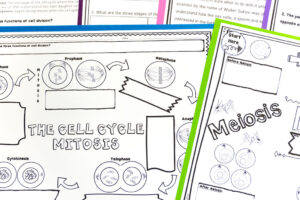Science teachers, are you looking for ways to add reading into your science classroom? Here are some quick wins that you can implement today!
Five Ways to Include Reading in your Science Class
Read Alouds
One way to include literacy skills in your science classroom is by choosing a novel to read aloud to your class. Then, choose to read the novel a few minutes a day, either at the beginning of class to settle down your students or at the end of class to keep students from getting up and mingling by the classroom door.
Here are some ideas of reading books you can use in your science classroom:
- Flush by Carl Hiassen
- The Disappearing Spoon (Young Readers Editions) by Sam Kean
- A Long Walk to Water by Linda Sue Park
- The Boy Who Harnassed the Wind by William Kamkwamba
- Life as We Knew It by Susan Beth Pfeffer
Yes, science needs to be fun, and students learn through hands-on activities but do you incorporate any note-taking skills in your science classroom? Using note-taking strategies to start your unit can be beneficial for students to review and reference their learning. Here are a few ways to incorporate notetaking strategies into the classroom.
- Graphic organizers: Use the organizers to help students uniquely summarize their learning.
- Fill-in Notes: Don’t waste valuable class time having students write out pages and pages of notes. Fill in notes allow students to take notes, pay attention, and copy important information they’ll need to know for the unit.
- Margin Notes: Using worksheets? Have students take notes in the margins to summarize each paragraph.
Summarizing Science Concepts
Summarizing is a difficult reading strategy but can help tell whether or not the students understand the concept. Of course, you can have students summarize in a simple paragraph, but if you want to keep their writing skills concise. Here are a few strategies that you can use to accomplish this.
- CER Claim, Evidence, Reasoning Method: Students will summarize their learning by stating a claim, use reasoning from a lab activity or text to add evidence, and back it up with scientific reasoning. Want graphic organizers to get started? Grab them here!
- 6 Word Summary: Challenge students to sum up their understanding of science using only 6 words! Students will love that it barely requires writing; however, students will be challenged to wrap it up in 6 words.
- Fake News! Have students summarize an article or worksheet. They write down 5 pieces of information, one of them being fake. Then, they share their responses with other students who need to pinpoint the fake news. Students will enjoy trying to trick one another and will help to reinforce reading skills in your science classroom.
- 3-2-1 Summary: This summary is also a bit structured in that students will write down 3 things they found interesting, 2 questions they have, and 1 connection they can make to the topic.
Science Websites
Another quick way to improve reading skills in science is to have students mark up the text. Then, as they read, students can use symbols, images, or short notes to show agreement, ask questions, or highlight new vocabulary terms.
Some symbols you can use are:
? – Question
! – Agreement
✔ – I knew this
* – This is important
While hands on learning should dominate science class, incorporating reading skills in your science classroom will help with student understanding. So which one of these ideas will you try out?





